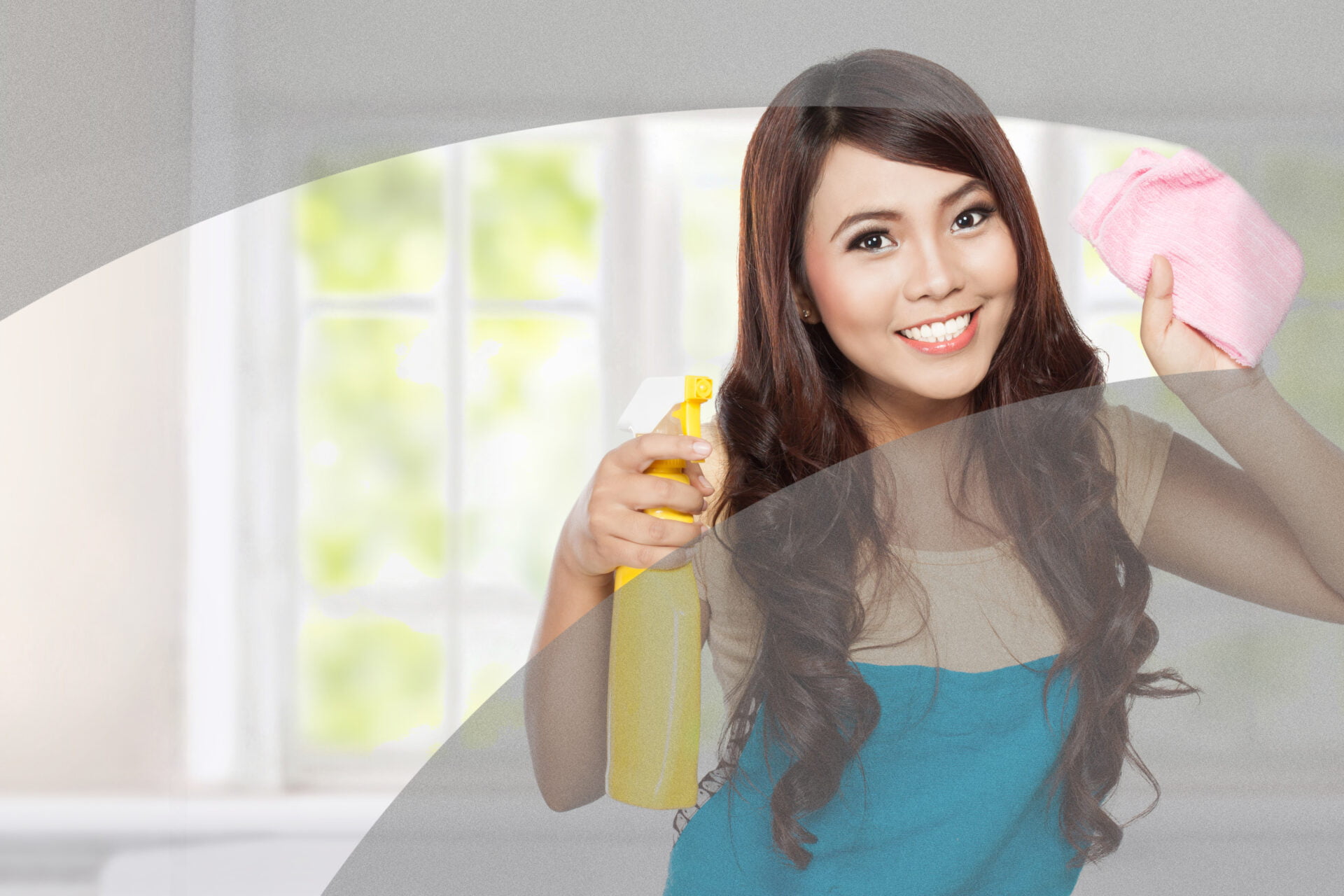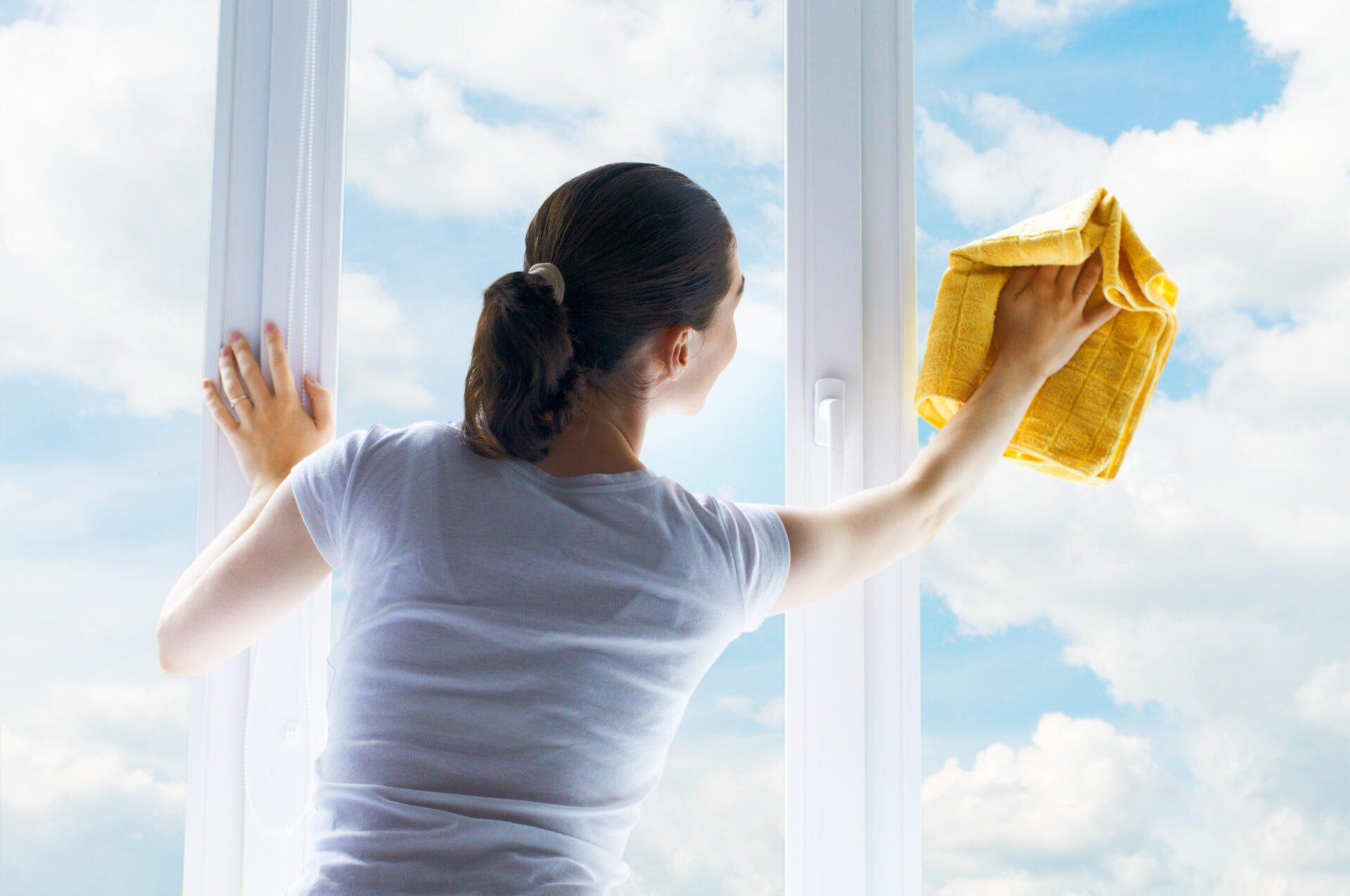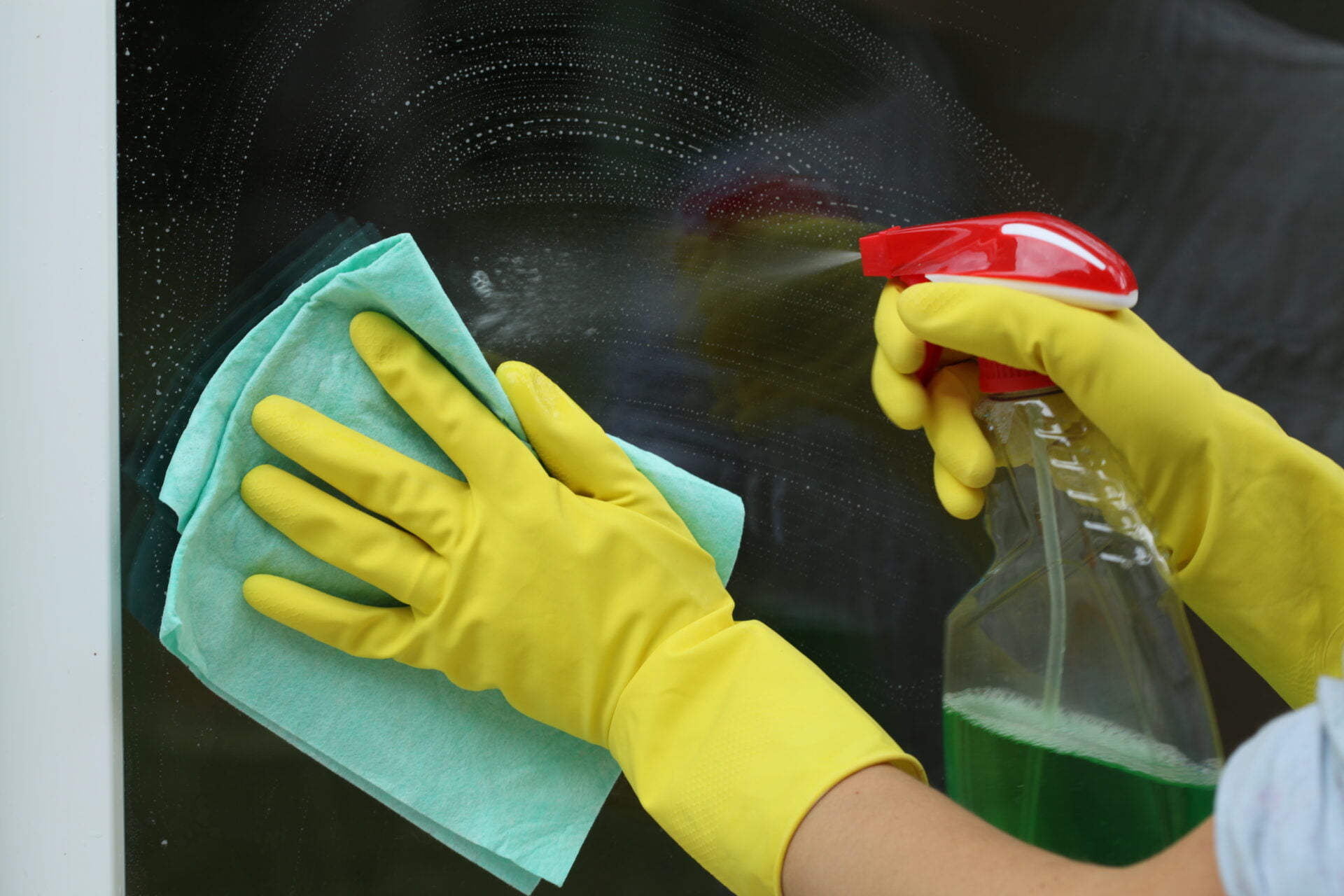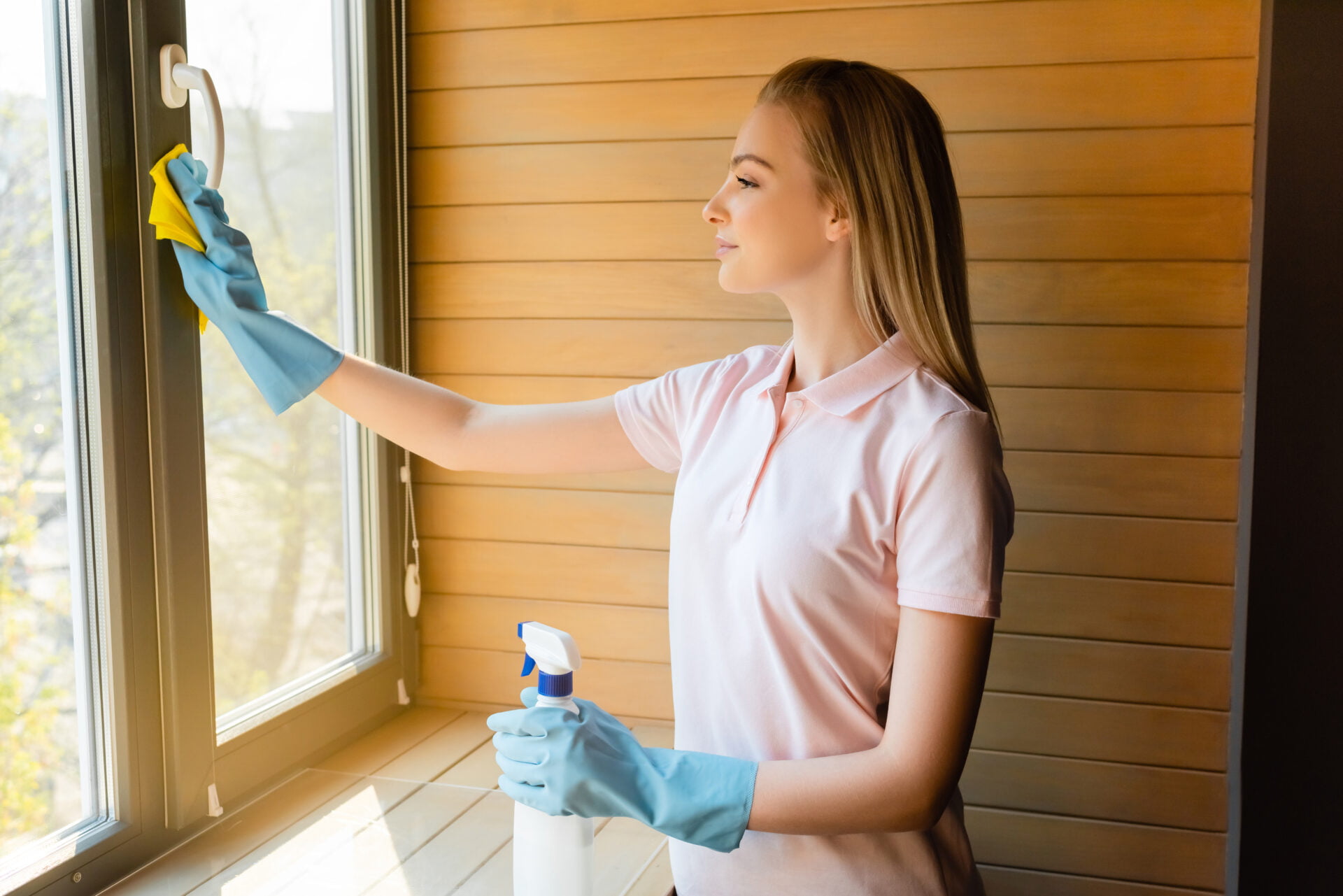Which window and glass cleaners are better for your indoor air quality yet also deliver that streak-free shine with no smudges or residue? Mamavation investigated the most popular brands available in the United States to answer the question: what is the best non-toxic window & glass cleaner to clean glass surfaces? You’ve trusted Mamavation to bring you topics like best disinfectants, safest green beauty makeup without PFAS “forever chemicals,” and best all-purpose cleaners, now join us for the best (and worst) cleaners with more natural ingredients to give you those streak-free windows without the hormone-disrupting chemicals.
Disclosure: This post was medically reviewed by Sondra Strand, RN, BSN, PHN. This post also contains affiliate links.

Table of Contents
Volatile Organic Compounds (VOCs) Inside Window & Glass Cleaner Are Problematic to Humans & the Environment
It’s best to opt for non-toxic window & glass cleaners. Cleaning products of all kinds can be problematic to the environment and human health, including everyday window & glass cleaners. The volatile organic compounds (VOCs) emitted from common cleaning products in your home evaporate into the air and can be inhaled. Once in a while is not so much a problem, but exposure to these contaminants over time can lead to health problems.
VOCs after being emitted from cleaners can then attach themselves to dust particles, which are then inhaled OR they can escape outdoors where they find themselves in outdoor air. In terms of the environment, the latest research points to household cleaners being more problematic now to outdoor air than car fumes.
When outside, VOCs interact with sunlight and other substances and undergo chemical reactions that contribute to poor air quality. Compared to the amount of pollution coming from automobiles, common household products are surprisingly now worse for the environment.
New research cites “pesticides, coatings, printing inks, adhesives, cleaning agents, and personal care products” as key sources of VOCs inside the home. Therefore, cutting down on toxic cleaning products will help clean up the air inside your home and cut down on your own personal pollution. Non-toxic glass cleaners are the best glass cleaners. They may need a bit more elbow grease, but they are better for your health.

Indoor Air is Typically Between 2-5x More Polluted Than Outside Air
The truth about your indoor air can be unsettling when you first realize how polluted it can be and how that can impact your health. Generally speaking, the more time you spend indoors the more you are exposed to the contaminants inside your indoor air. In fact, 90% of your time is likely spent indoors. Therefore, it’s important to consider your indoor air quality as a way to improve your overall health.
Even though you can’t control the air you breathe outside, you CAN control the type of air you breathe indoors. It’s estimated that indoor air quality can be anywhere from 2-5x more polluted than outside, so focusing on indoor air is wise.
Cleaning up VOCs inside your home is as simple as following these steps:
- switching to safer cleaning products, (especially the non-toxic window & glass cleaners from this investigation!)
- avoiding anything with synthetic fragrance (sorry Glade Plug-ins, Yankee Candles & perfumed personal care products!),
- opening a window,
- getting lots and lots of NASA-approved plants,
- cleaning up dust,
- getting a powerful air purifier. (These are our favorite air purifiers here.)

Non-Disclosure of Ingredients is Very Problematic in Window & Glass Cleaners
After evaluating the ingredients of over sixty products to determine which are the best non-toxic window & glass cleaners, we found one of the biggest issues is the non-disclosure of ingredients. The lack of ingredient disclosure in terms of fragrance & surfactants makes it easier for manufacturers to hide ingredients that are problematic. This leaves the door open to hiding problematic chemicals that can disrupt hormones in humans and the environment.
The problem of non-disclosure of ingredients is very common in the “cleaning” aisle in general, but for people with allergies or who suffer from autoimmune conditions, this can be a nightmare. Why? Just because an ingredient is not on the label, doesn’t mean it’s not inside the product inside terms like “fragrance” or “surfactants” and thus, it can do you harm.
Looking for 100% ingredient disclosure is one of the primary ways we evaluated products for this investigation of non-toxic window & glass cleaners. If they were not 100% transparent about the ingredients on the label, they were marked down for your safety.

Ingredients to Avoid in Window & Glass Cleaners to Protect Your Indoor Air Quality & Health
Here is a simple list of chemicals to avoid when purchasing the best non-toxic window & glass cleaner products. You’ll also find these ingredients inside cleaners used for stainless steel appliances, or products that claim to only use plant-based ingredients. They range in toxicity from very toxic to just an irritant.
- Methylchloroisothiazolinone and Methylisothiazolinone: These chemicals are preservatives and we found them in a surprising number of glass and window cleaners. Some of the hazards they pose include being an irritant to skin and if inhaled, Skin allergies, especially when both are found in the same product, Possible neurotoxicity and organ toxicity has been shown in lab studies. Most people don’t know if they or their children are allergic to these chemicals, these are ones you’d want to avoid in your home.
- Sodium Laureth Sulfate and Sodium Lauryl Sulfate: SLS and SLES are surfactants helping products to clean. Even when naturally derived, they can be harmful. The Journal of the American College of Toxicology has shown that they can be an eye or skin irritant. There is also debate on whether or not SLS is a human carcinogen; other research indicates it may damage the environment. Both can be harmful to the environment.
- Undisclosed Fragrance/Perfume: Fragrances are a problem because they can be formulated from thousands of available chemicals, many of which can be irritants, allergens or phthalates. Companies can legally hide ingredients in “fragrance” or “perfume” on the bottle because of laws protecting them from revealing their formulations. (Ironically, these things can be reverse-engineered in a lab, so there is no such thing as a “secret” formula anymore, but I digress.) Today, hiding ingredients in “fragrance” means they are just not being transparent. Most companies won’t list the ingredients of their proprietary blends.
- PEGs/Polysorbates: These chemicals are formed by condensing water and ethylene oxide. They can be contaminated with carcinogenic chemicals such as 1,4-dioxane. These are concerning because they can easily penetrate the skin. Look for “PEG-“ followed by a number, or polysorbates.
- Ethylene Glycol Monobutyl Ether (EGBE) or 2-butoxyethanol & other glycols: This is a chemical used to make antifreeze. It’s a volatile chemical that evaporates into the air as cleaning. The CDC lists it as relatively low harm unless ingested, but it can be absorbed through the skin during cleaning. Animals studies suggest there may be a link to reducing fertility among females. Ingestion can also lead to poisoning. Exposure also can impair the development of organs in fetuses and impair the kidneys.
- Ethoxylated Compounds: Ethylene oxide, a chemical that has been linked to different kinds of cancer, is added to these ingredients. (PEGs and SLS or anything ending with the prefix -eth are also ethoxylated.) They may also be contaminated with other hazardous ingredients, such as 1,4-dioxane.
- Methyl Alcohol: Also known as methanol, this chemical can cause eye damage, respiratory irritation, and skin allergy or irritation. It’s also possibly toxic to marine life.
- Artificial Dyes: Many dyes are known to be toxic. In fact, like Red Dye #40, have been linked to ADHD. Most manufacturers are now using a dye brand called Liquitint. SkinSafe doesn’t list any known problems with these dyes, however, EWG gives all Liquitint colors a grade of only “C” in their Guide to Healthy Cleaning since more information is needed about these “polymeric colorants.”
- Alkyl Dimethyl Benzyl Ammonium Chlorides and other “Quats”: Quaternary ammonium compounds are widely used as surface disinfectants. These cationic detergents are synthetic derivatives of ammonium chloride. The EPA has listed some “quats” as having a high risk for human health, however, there isn’t information on all of them. They are also linked to asthma, allergies, and skin irritation. Other ingredients you may see are things like polyquaternium, Benzalkonium chloride, Cetalkonium chloride, Cetrimonium chloride, Lauryl dimonium hydrolysed, collagen, Stearalkonium chloride, Diethyl ester dimethyl ammonium chloride, Dialkyl dimethyl ammonium methyl sulfate, Hydroxyethyl methyl ammonium methyl sulfate, Chemical DTDMAC (ditallow dimethyl ammonium chloride); also called quaternium-18, Quaternium-26 and other numbers.
- Octylisothiazolinone: May be a skin irritant or allergen.
- Coco-betaine or Cocamidopropyl betaine: According to the EWG database, these ingredients can be contaminated with impurity 3-DIMETHYLAMINOPROPYLAMINE, which can cause skin burns, eye damage, and allergic reactions when used in cleaners. It can also contain nitrosamines, which are carcinogens.
- Ethanolamine: Likely allergen or skin toxicant. Likely immune and respiratory toxicant or allergen. Classified as “expected to be toxic or harmful” by Environment Canada Domestic Substance List.
- Butylphenyl Methylpropional: This chemical, also known as lilial, may impact the immune system or be an allergen. It’s also been associated with endocrine disruption.
- Benzyl Salicylate: This immune system toxicant is also associated with endocrine disruption. It could also be an environmental toxin.
More on Surfactants In Window & Glass Cleaners & Their Impact on the Planet
There’s a little bit of overlap here, but we wanted to go over surfactants because they are so important to understand. Surfactants are one of the main ingredients you’ll find in products like dishwashing detergent, all-purpose cleaners, air fresheners, laundry detergent, furniture polish, and window & glass cleaners. They are used to stir up activity on the surface that is being cleaned to help trap dirt and remove it from the surface. So they are very good at say cleaning off bird droppings or soap scum on the window. Most of the time, you’ll find them in liquids.
Surfactants can either be anionic, nonionic, cationic, or amphoteric, but in terms of products like glass & window cleaners, most of what you will see are anionic and nonionic surfactants.
- Anionic surfactants: Glass & window cleaners have lots of anionic surfactants, which have a negative charge. Anionic surfactants create lots of foam when mixed and are excellent for lifting and suspending particulate soils, but they do not cut grease very well. These ingredients can be produced from a range of raw fats and oils, including soybean, palm, tallow, and coconut-type ingredients. Examples of this are sulfates, like sodium lauryl sulfate (SLS), sodium laureth sulfate (SLES), ammonium lauryl sulfate (ALS), ammonium laureth sulfate (ALES), sodium stearate, sulfonates, and gluconates like potassium cocoate.
- Nonionic surfactants: When it comes to cutting grease, the use of nonionic surfactants are good at emulsifying oils and are better than anionic surfactants at removing organic soils. You’ll find lots of formulations where the two are used together to create dual-action to lift and suspend particulate soils, but also emulsify oily soils. These surfactants have a neutral charge. Examples of nonionic surfactants include ethoxylates like fatty alcohol ethoxylates, alkoxylates, cocamides like cocoamide monoethanolamine (Cocomide MEA), cocamide diethanolamine (Cocamide DEA), amine oxides, sulfoxides, nonylphenols, and nonylphenol ethoxylates. These chemicals range in toxicity based on what they are made of.
- Cationic surfactants: These surfactants have a positive charge and cannot be used with anionic surfactants because they lose their usefulness. You’ll find these surfactants more in anti-static products, like fabric softeners, or antimicrobial agents, like disinfectants. An example is alkyl ammonium chloride.
- Amphoteric surfactants: These surfactants are both positive and negative and are more often used in shampoos and cosmetics and other personal care products. Examples are betaines and amino oxides.
One of the biggest problems with surfactants (anionic & nonionic) is their effects on aquatic life. So for the purposes of this investigation, the more and harsher surfactants used, the lower the product will rank.
Simple Homemade Window Cleaner Recipe
Now if all this information is too complicated and worrisome, you can always make your own DIY window cleaning solution, pour them in a spray bottle, grab a microfiber cloth (or paper towels) and go to town! DIY window cleaners are very simple and typically contain some of the following ingredients:
- dish soap
- vinegar
- citrus peels or essential oils
- warm water
Most people have these simple ingredients at home and can quickly mix up a batch of homemade glass cleaner to solve all their problems. You can vary your recipe between these ingredients, but we use 1 cup of white vinegar, 1/2 teaspoon of dish soap, citrus peels, or a few drops of essential oil, and 2 cups of warm water. This simple recipe will attack grime on windows or fingerprints and leave them streak-free without having to purchase anything from the store in a plastic bottle. It’s the best homemade window cleaner.
What type of towel do we recommend? We actually prefer microfiber towels to clean things like bathroom mirrors or tile. We understand it’s mostly plastic, but in this case, we feel it’s a good use of plastic. Microfibers towels easily clean mud, bugs, and whatever else you throw at them. After you are done, simply throw them in the laundry.

Mamavation’s Investigation of Non-Toxic Window & Glass Cleaners
Mamavation evaluated over 60 popular glass and window cleaners. We looked for 100% ingredients disclosure, various hormone-disrupting chemicals, known carcinogens, and chemicals that are problematic to the environment. Some of these window cleaners are also known to clean marble, granite, exterior windows, shower doors, or clean car windows.
We divided the products into three categories:
- Not Our Favorite Window & Glass Cleaners: This category contains products that we do not recommend for any of the following reasons: (1) does not identify any ingredients on their website so we cannot evaluate, (2) contains several problematic ingredients discussed in this post, & (3) does not disclose specific ingredients like surfactants or fragrance and may hide behind the marketing of things like “plant-based.”
- Better Window & Glass Cleaners: These products are better but still have some issues. Here are some of the issues we found in this category: (1) non-disclosure of “natural” fragrance, (2) non-disclosure of “natural” or “plant-based” surfactants, or (3) contains some of the problematic ingredients we discussed in this post but not an overwhelming amount. When using these brands, please ensure your home has proper circulation for ingredients that get into the air to escape outside.
- Best Window & Glass Cleaners: This category is full of products we recommend. These products are displaying 100% ingredient disclosure in all fragrances (including essential oil blends) and surfactants. They also do not contain any ingredients that are problematic to human health (if used as directed.) We also did not take issue with the ingredients used. Reminder, this is not a product to expose to the skin or to drink, so please take precautions when using, however, when used as directed, they should be fine.

Not Our Favorite Window & Glass Cleaners
This category contains products that we do not recommend for any of the following reasons: (1) does not identify any ingredients on their website so we cannot evaluate, (2) contains several problematic ingredients discussed in this post, & (3) does not disclose specific ingredients like surfactants or fragrance and may hide behind the marketing of things like “plant-based.” These are not considered non-toxic window and glass cleaners.
- Chemical Guys Streak Free Window Cleaner
- Cinch Spic & Span Glass Cleaner
- Clorox Commercial Solutions Formula 409 Glass & Surface Cleaner
- Ecover Window And Glass Cleaner
- Frosch Glass Cleaner Bio Spirit
- Glass Plus Glass Cleaner
- Goodbye (from Legend Brands) Goodbye Natural Glass Cleaner
- Green Works Naturally Derived Window Cleaner
- Hope’s Perfect Glass Cleaner
- Jaws Glass Cleaner
- Legacy of Clean Glass Cleaner, Citrus
- Mrs. Meyer’s Glass Cleaner Lavender
- Rejuvenate Outdoor Glass Cleaner
- Sprayway Glass Cleaner Foaming Aerosol Spray
- Up & Up (Target Brand) Glass Cleaner
- Walmart Great Value Glass Cleaner
- Windex Original Glass Cleaner
- Windex Ammonia-Free Glass Cleaner
- Windex with Vinegar Glass Cleaner
- Windex Wipes
- Windex Aerosol Foaming Glass Cleaner
- Windex Outdoor Glass & Patio Cleaner
- Zep Streak-Free Glass Cleaner
Better Window & Glass Cleaners
These products are better but still have some issues. Here are some of the issues we found in this category: (1) non-disclosure of “natural” fragrance, (2) non-disclosure of “natural” or “plant-based” surfactants, or (3) contains some of the problematic ingredients we discussed in this post but not an overwhelming amount. When using these brands, please ensure your home has proper circulation for ingredients that get into the air to escape outside.
- 9 Elements All-Purpose Cleaner Cleaning Vinegar Spray
- Athos Glass & Window Cleaner
- Bean & Lily Glass Cleaner Lemongrass Green Tea
- Better Life Glass Cleaner Unscented
- Biokleen Glass Cleaner Spray Concentrate Multipurpose
- Earth Friendly Products ECOS Vinegar Cleaner
- Everspring Glass Cleaner Lemon & Mint
- GO By Greenshield Organic Glass Cleaner Fresh Mint
- Grove Co Glass Cleaner Concentrate Orange & Rosemary Scent
- Grove Co Glass Cleaner Concentrate Free & Clear
- Grove Co Glass Cleaner Concentrate Lavender & Thyme Scent
- Haus Naturals Streak-Free Glass Cleaner
- Honest Company Conscious Cleaning Glass Starter
- Lemi Shine Glass + Surface Cleaner
- Method Glass Cleaner Mint
- Nature’s Promise Glass Cleaner
- Plant Therapy Defender™ Glass Cleaner
- Puracy Multi-Surface Cleaner Lemongrass (Use discount code “MAMAVATION20” for 20% off products)
- Rebel Green Glass Cleaner Peppermint Lemon
- Rebel Green Glass Cleaner Pink Lilac
- Seventh Generation Glass Cleaner Sparkling Seaside Scent
- Seventh Generation Glass Cleaner Free & Clear
- Simple Green Naturals Glass & Surface Care
- Soganics Eco-Friendly Window Glass Mirror Spray Cleaner
- The Laundress Glass & Mirror Cleaner
Best Non-Toxic Window & Glass Cleaners
This category is full of our top picks for non-toxic window & glass cleaners. These products are displaying 100% ingredient disclosure in all fragrances (including essential oil blends) and surfactants. They also do not contain any ingredients that are problematic to human health (if used as directed.) We also did not take issue with the ingredients used. Reminder, this is not a product to expose to the skin or to drink, so please take precautions when using, however, when used as directed, they should be fine.
- 365 by Whole Foods Market Glass Cleaner Unscented
- Aspen Clean Glass Cleaner Lime
- Attitude Hypoallergenic Window & Mirror Cleaner, Citrus Zest
- Aunt Fannie’s Glass & Window Vinegar Wash
- Back to Basics Cleaner Than Clean Cleaner (Use discount code “MAMAVATION” for 5% off products!)
- Branch Basics Streak Free Glass Cleaner (Use discount code “MAMAVATION” for 15% off starter kits!)
- Citra Solv HomeSolv Window & Glass Cleaner Valencia Orange
- Clean+Green VinegarTech Glass Cleaner
- Earth Friendly Products Window Cleaner with Vinegar
- Earth Friendly Products Window Cleaner, Bamboo Lemon
- Gaia All-Purpose Cleaner
- Pure Haven Glass Cleaner White Vinegar Peppermint (also available in 32oz refill)
- Simple Truth Organic Glass Cleaner Eucalyptus Mint
- Sun & Earth Glass Cleaner Lemongrass & Sage
- Truly Free Non-Toxic Glass Cleaner (Use “MAMAVATION” for 25% off products!)






 Glyphosate in Popular Bread, Oats, Legumes, Protein Powders, & Bars 2022
Glyphosate in Popular Bread, Oats, Legumes, Protein Powders, & Bars 2022
Are any “foaming” window cleaners SAFE/Safer?!?